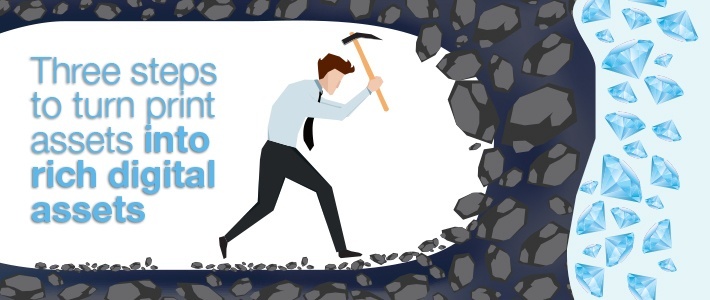Whitepapers, research reports and client magazines are the mainstay of an intelligent B2B content plan. When created with purpose and executed with flair, these three pillars of publishing deliver value to the reader and underscore an organisation’s credentials as expert in its field.
So far so good. However, when transitioning from print to digital ‘the bundle’ presents a problem of discoverability and of missed opportunity.
Buried within a client magazine is a series of articles that have value as standalone editorial pieces. Moreover, buried within each article are component parts that could stand alone. Ditto within the research report. Ditto within the whitepaper. These are hidden gems to be mined. Collectively these separate assets increase the chances of a company’s excellent content being surfaced by search engines, shared via social media and linked to from elsewhere. Bundled together, there’s only one chance.
So what’s the solution? Grist takes a three-step approach: unbundle, repurpose and amplify. Let’s take each in turn:
Unbundle. First deconstruct the whitepaper, research report or magazine into component parts – article copy, box-out copy, images, graphs, infographics, tables and so on. Take another look at the body copy and determine whether that can be unbundled further, perhaps around particular topics, themes, arguments or stories. Existing subheadings may even provide a ready-made break point between those component parts. Once suitably atomised, decide which of those separate assets can stand alone. Invariably, most can.
Repurpose. A 15-page whitepaper may have 10 separate and usable parts to it. The executive summary, for example, may work perfectly as a LinkedIn long-form post. It may require a little “re-nosing” (adapting the first paragraph, say) and will need a dedicated headline and kicker. A table might work as a standalone blog post, requiring an intro and outro paragraph of text to provide context. (Research by Hubspot into 7,000 company websites found that an increase in blogging activity from 3-5 times a month to 6-8 times a month almost doubled lead generation.)
Meanwhile, an infographic would work pinned to Pinterest, the graph embedded into a tweet and a collection of the visual assets threaded into a compelling SlideShare presentation – with a little topping and tailing, of course. By the way, Slideshare is the most popular content-sharing site for professionals.
Amplify. Use a mixture of all channels available to push the repurposed content out. Communications professionals increasingly reach for the PESO model as a useful framework to organise and implement PR and marketing activity around content. PESO? That’s paid, earned, shared and owned media. In future posts we’ll look in more detail at each of the PESO channels and discuss how they can help amplify content that’s been unbundled and repurposed.
Which approach makes most sense for you? A single PDF buried on your website and hidden from search engines, or a dozen search-friendly pieces of content pulling in targeted traffic and providing a plethora of opportunities across other platforms?


